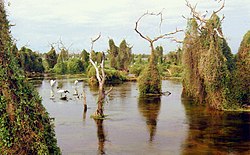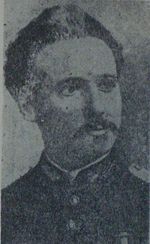Formosa Province
Formosa
Provincia de Formosa (Spanish) | |
|---|---|
| Province of Formosa | |
 | |
|
UTC−3 (ART) | |
| ISO 3166 code | AR-P |
| HDI (2021) | 0.822 very high (23rd)[3] |
| Website | formosa |
Formosa Province (Spanish pronunciation: .
Source of the provincial name
The name of the city (and the province) comes from the archaic
History

Native inhabitants of these lands include the
Sebastian Cabot and Diego García de Moguer first explored the area at the beginning of the 16th century trying to find a route from Viceroyalty of Peru to Asunción. Because the Pilcomayo and Bermejo Rivers are so shallow, the attempts to set a route towards Asunción was abandoned.
The area's first European settlement, Concepción del Bermejo, was established in 1585. Following the establishment of Argentine and Paraguayan independence in the 1810s, the area fell under dispute between the two nations, a matter not settled until after the War of the Triple Alliance (1865–70). Commander Luis Jorge Fontana founded the settlement of Formosa in 1879, bringing the remote area into national attention and helping to secure a territorial status in 1884.
Formosa had less than 20,000 inhabitants in 1914; but in 1955, when it acquired the status of Province by decree of President
Geography
Located within the geographic coordinates 26° 22°30' south, and 57°30' 62°25' west, the plains run between the Bermejo and Pilcomayo Rivers with a slight inclination towards the southeast. Due to this flatness, riverbeds are not stable, and small lagoons that are slowly reabsorbed arise.
Climate

The average annual temperature is 21 °C; during summer it can rise to 45 °C.
The
Formosa's protected areas are the Río Pilcomayo National Park and the Formosa National Reserve.
The antipode relationship with Taiwan

Coincidentally, part of the province is the antipode to northern Taiwan, which was also known as "Formosa".[citation needed] (Taiwan was named "Formosa" by Portuguese explorers since at least 1542.)[6]
Fauna
Formosa, a province located in northern Argentina, is renowned for its exceptional fauna diversity. The region's diverse ecosystems, encompassing wetlands, forests, grasslands, and rivers, provide a wide array of habitats for a rich variety of animal species.
The fauna of Formosa showcases a remarkable assortment, playing a vital role in preserving the ecological balance of this vast environment and contributing to the overall functionality of the ecosystem.
Nevertheless, the indigenous animals of Formosa have faced significant declines as a result of human activities. The yaguareté, once a prevalent inhabitant of the forests and jungles, has experienced a population decrease. Other felids, such as pumas and various feline species, also inhabit the area. The humid forest areas are home to tapirs and monkeys, with the distinctive howler monkey, known as carayá, standing out among them. In the drier forest zones, armadillos, including the giant armadillo, locally known as tatú carreta, alongside foxes and rodents commonly found in the Chaco region, have established their habitats. The bird and reptile populations in Formosa share similarities with those found in other provinces of Argentina.
Mammals
In Formosa Province, one can still find both large and small feline species, such as the jaguar, puma, ocelot, mountain cat, and pampas cat.
In the grassland areas, the maned wolf, known as "aguara-guazu," can be found, although its population is currently declining. In more open and cleared areas, armadillos such as the mulita, giant armadillo, mataco, and peludo can be found.
Other abundant mammals in Formosa include coatis, tapirs, small deer known as corzuelas, foxes, skunks, vizcachas, overa weasels, howler monkeys or caraya, and various rodent species.
The 27 species of mammals that have been identified in Formosa are:
- Giant Anteater
- Southern Tamandua
- Marsh Deer
- Gray brocket
- Collared Peccary
- White-lipped Peccary
- Maned Wolf
- Crab-eating Fox
- Pampas Fox
- Jaguar
- Puma
- Jaguarundi
- Geoffroy's Cat
- Tayra (Eira barbara)
- Neotropical Otter
- Crab-eating Raccoon
- South American Coati
- Screaming Hairy Armadillo
- Southern Three-banded Armadillo
- Nine-banded Armadillo
- Common tapeti
- South American Tapir
- Azara's Night Monkey
- Black Howler Monkey
- Capybara
- Chacoan Mara
- Brazilian Guinea Pig
Birds
Formosa is one of the preferred destinations for nature enthusiasts due to the excellent state of conservation of its ecosystems across much of its territory. It is renowned for its rich birdlife, with many species easily observable during a day trip into nature.
Within this province, one can encounter rheas (ñandúes), various species of partridges among the terrestrial birds, and herons among the aquatic species. Other notable bird species include toucans, southern lapwings, crested caracaras, crows, caracaras, magpies, woodpeckers, kingfishers, different species of doves and ducks, guans, hoatzins, ovenbirds, cattle tyrants, fork-tailed flycatchers, owls, and nightjars, seedeaters, swans, and spoonbills. In the areas near rivers, especially along the Paraná River, common parakeets and the yellow-chevroned parakeet and blue-fronted parrot are abundant.
It could be said that half of Argentina's bird species are found in Formosa, as 367 species have been recorded out of the 1,020 documented across the entire country. These are just a few examples of the diverse avian inhabitants of the province: Some of the birds found in Formosa include:
- Rhea
- Southern Screamer
- Red-and-green Macaw
- Brazilian Teal
- Glittering-bellied_emerald
- Black-throated Mango
- Andean Flamingo
- White-barred Piculet
- Toco Toucan
- Ringed Kingfisher
- Scarlet Macaw
Reptiles
Formosa is home to a variety of reptiles, each with its own characteristics and level of danger. Among them are the lampalagua, the false yarará, the yarará or cross snake, and the coral snake, with the latter two being highly venomous. In addition to these venomous snakes, the chaco region is also inhabited by the overas and coloradas iguanas, as well as land turtles.
The reptiles found in Formosa include:
- Yacare caiman
- Broad-snouted caiman
- Yellow anaconda
- Boa constrictor
- Argentinian rainbow boa
- Micrurus altirostris
- South American rattlesnake
- Crossed pit viper
- Ameiva
- Scorpion mud turtle
Economy

Remote and saddled by its inhospitable geography and climate, Formosa's economy has long been one of Argentina's poorest. Its economy in 2006 was estimated at US$2.082 billion, or, US$4,278 per capita.[7] Its economy is the third-smallest and second-least developed in Argentina, yet it has shared in Argentina's recovery since 2002 very well.[8]
Poorly industrialized, Formosa's economy is based on
Cattle in Formosa exceed 1.5 million head and ranching has long been the agricultural mainstay of the province. Like elsewhere in Argentina, agriculture has long since been overtaken by other activities and amounts to about 10% of Formosa's output (somewhat more than average).

Cotton represents half of the agricultural wealth of the province followed by soybean (25,000 tons a year) and maize (55,000 tons), who have experienced a less dramatic invigoration after the 2001 crisis.
Bananas, grown mainly for domestic consumption, amount to a steady annual average crop of 70,000 tons. Citrus and juice production for exportation, specially grapefruit, is growing rapidly, with 1,200 planted hectares and an annual production of around 15,000 tons.
Others;
Tourist infrastructure is barely developed. Sites of interest include the city of Formosa, the Río Pilcomayo National Park, Bañado La Estrella, Laguna Yema, Herradura town, and Misión Laishí.
Government
The provincial government is divided into the usual three branches: the executive, headed by a popularly elected governor, who appoint the cabinet; the legislative; and the judiciary, headed by the Supreme Court.
The Constitution of Formosa Province forms the formal law of the province.
In Argentina, the most important law enforcement organization is the Argentine Federal Police but the additional work is carried out by the Formosa Provincial Police.
Political division
The province is divided into nine departments:


| Department | Principal city | Population (2022)[9] | Other Municipalities |
|---|---|---|---|
| Bermejo | Laguna Yema
|
16,576 | Los Chiriguanos, Pozo de Maza, Pozo del Mortero |
| Formosa | Formosa | 276,309 | Colonia Pastoril, Gran Guardia, San Hilario, Mariano Boedo, Mojón de Fierro, Villa del Carmen, Villa Trinidad |
| Laishí | San Francisco de Laishi | 19,228 | Banco Payaguá, General Lucio V. Mansilla, Herradura, Tatané, Villa Escolar |
| Matacos | Ingeniero Juárez | 17,551 | |
| Patiño | Comandante Fontana | 77,974 | Bartolomé de las Casas, Colonia Sarmiento, El Recreo, Estanislao del Campo, Fortín Leyes, Fortín Lugones, General Manuel Belgrano, Ibarreta, Juan G. Bazán, Las Lomitas, Posta Cambio Zalazar, Pozo del Tigre, San Martín, Subteniente Perín, Villa General Güemes |
| Pilagás | El Espinillo
|
20,783 | Buena Vista, Misión Tacaaglé, Portón Negro, Tres Lagunas |
| Pilcomayo | Clorinda | 98,490 | Laguna Blanca, Laguna Naick Neck, Palma Sola, Puerto Pilcomayo, Riacho He-Hé, Riacho Negro, Siete Palmas |
| Pirané | Pirané | 70,300 | El Colorado, Mayor Vicente Villafañe, Palo Santo, Villa Dos Trece |
| Ramón Lista | General Mosconi | 17,495 | El Potrillo |
Villages
- Herradura, settlement
- Villa General Güemes, settlement
State anthem
Formosa has its own anthem, called "Himno Marcha Formosa". On April 8, 1955, the Anthem "Marcha Formosa" was sung for the first time, in 1964 the definitive arrangement of it was made and it became official as a song. By decree No. 1471 of July 21, 1988, compulsory education was established in primary, secondary and tertiary establishments and its intonation in public events.
See also
References
- ^ "Nuevos datos provisorios del Censo 2022: Argentina tiene 46.044.703 habitantes". Infobae. 31 January 2023. Retrieved 2023-02-03.
- ^ "TelluBase—Argentina Fact Sheet (Tellusant Public Service Series)" (PDF). Tellusant. Retrieved 2024-01-11.
- ^ "El mapa del desarrollo humano en Argentina" (PDF). United Nations Development Programme. 25 June 2023.
- ^ Reseña Archived 2007-05-28 at the Wayback Machine (Spanish)
- ^ Rock, David. Argentina: 1516-1982. University of California Press, 1987.
- ^ Sujuan, Zhan (2012-05-22). "The Taiwan Encyclopedia". Council for Cultural Affairs. Retrieved 2012-05-22.
- ^ "El déficit consolidado de las provincias rondará los $11.500 millones este año" (in Spanish). Instituto Argentino para el Desarrollo de las Economías Regionales. Retrieved 10 July 2015.
- ^ I.A.D.E.R
- ^ "Informe diagnóstico Formosa" (PDF). Argentina unida. 1 July 2023.
External links
- Provincial government Archived 2000-12-06 at the Wayback Machine (Spanish)
- One-page info: economic info, with a map (can be enlarged)
- Tourist Office (Spanish)
- Encyclopedia Libre article (Spanish only)
- Provincial portal Archived 2008-12-21 at the Wayback Machine (Spanish only)
